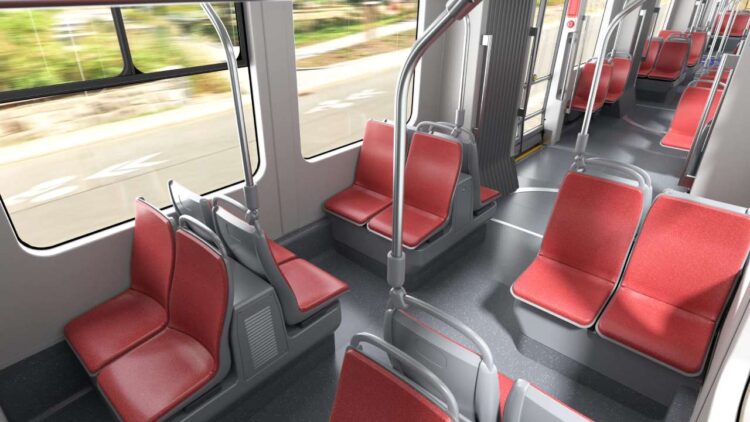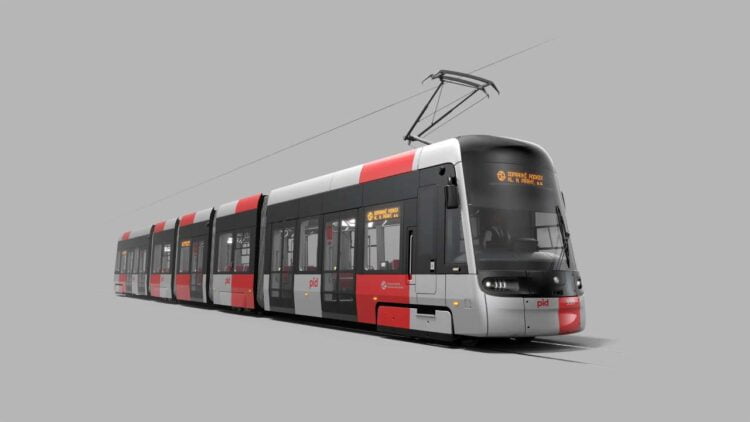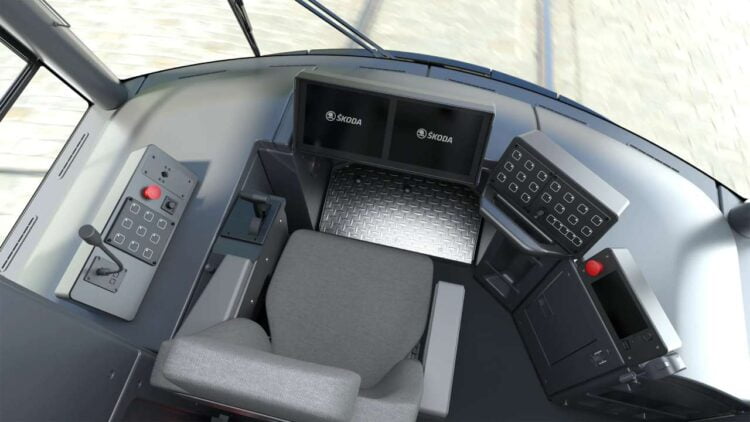Czech Republic capital city Prague has ordered up to two hundred modern, low-floor Škoda ForCity Plus Praha 52T trams.
The Prague Public Transit Company (DPP) has signed an eight-year contract with Škoda Group for an initial forty trams, with the option of a further one hundred and sixty. The contract’s total value is nearly CZK 16.602 milliard (around £575m), making it one of the largest investments in new trams in DPP’s modern history.
The first twenty new trams are due to arrive in Prague in December 2025, with a further twenty arriving a year later, by the end of December 2026.
The Škoda ForCity Plus Praha 52T is a one-way, five-part, 100% low-floor tram without a single step in the whole of the passenger compartment, including the space above the bogies. A team from Škoda Group led by Tomáš Chludil designed the 32-metre-long vehicle, which is fitted with full-carriage green air conditioning with ecological refrigerant, an anti-collision system, automatic passenger counting, energy-saving LED interior and exterior lighting.
The tram has seventy padded seats, forty four facing forward and twenty six facing to the rear.

The new tram can carry thirty three more passengers than the previous 15T trams, an increase of almost sixteen percent. The tram’s information system has six large screens across the width of the aisle, and the tram boasts amore intuitive operation of the door opening buttons and signalling to the driver.
Particularly in its its historic centre, Prague has narrow streets with sharp curves and steep gradients, significant height differences in the tram network, but also long and relatively straight routes. The design of the tram takes these factors into account, combining a multi-link vehicle with two pivoting bogies under the outermost links and two partly pivoting bogies under the inner chassis links. This combination made it possible for the vehicle to have a more accessible, airy passenger saloon with short, wider, and spacious joints, free of steps or other barriers.
It also makes the tram adaptable to any track profile, which will give smooth, comfortable and quiet journey, and will reduce wear and tear on wheels and tracks, thus extending the life of the vehicles. Designers predict up to fifty percent more wheel mileage than the 15T trams, and lower maintenance costs for the bogies and its most expensive components.

The new trams also feature:
- an anti-collision system, to help prevent accidents prevention, using a combination of dual LiDAR and HD-camera technology and precise localisation using off-line recorded HD maps and odometry;
- sustainable braking technology, using with an electromechanical braking system, chosen for its efficiency and sustainability.
The vehicle’s components are drawn from other successful Škoda projects, with the chassis frames taken from the ForCity Smart trams for Ostrava, Pilsen, and Brno, and the powerful traction motor from the ForCity Plus project for Frankfurt, Cottbus, and Brandenburg.
The inspiration for the tram’s design came from the five-part ForCity Plus tram for Bratislava, where the mileage was increased for a new set of wheels.
Several Czech companies will take part in manufacturing the trams by way of subcontracting, including DAKO-CZ, which will produce the electromechanical brake.
Technical parameters of the tram Škoda ForCity Plus Praha 52T:
- Vehicle length over bumpers: 31.99 m
- Vehicle width: 2.5 m
- Total vehicle capacity: 243 at 5 persons/m2
- Number of standing places: 173
- Number of seats: 70 in total, of which 44 in the direction of travel = 62% (PID Quality Standards require a minimum of 60%) and 26 in the opposite direction = 38%
- Low-floor section: 100% (all seats accessible without landings and stairs)
- Total number of chassis: 4 traction bogies (2 pivoting and 2 partly pivoting)
- Brake: electromechanical
- Diameter of new wheels: 640 mm
- Boarding height: 350 mm
- Doors: 5 double doors, each 1300 mm wide
- Driver’s door: external mechanical, internal sliding
- Vehicle life cycle: 30 years
- Design speed: 80 km/h
- Empty weight: 48 t

Zdeněk Hřib, 1st Deputy Mayor of the capital city of Prague for Transport and Chairman of the Supervisory Board of DPP, said, “Although Prague and DPP have purchased new trams type 14T and 15T in the past twenty years, they served to renew the fleet as a replacement for unviable high-floor trams, but not to increase the number of available vehicles. At a time when new lines were hardly built in Prague, this could have been enough. But we have started a tram boom in Prague. We are building new lines, last year we opened three lines with a total length of five kilometres, and we are preparing more. This year, for example, we will start building on Wenceslas Square. The new lines alone, which we plan to build in the period 2024-2027, will need 45 new trams. And it will be these 100% low-floor and quiet trams with an increased number of seats and an anti-collision system.”
Petr Witowski, Chairman of the Board of Directors and CEO of DPP, commented, “We have approached this public contract for the purchase of up to 200 new trams with the utmost care, just like other tenders. It was preceded by preliminary market consultations and the chosen form of negotiated procedure with publication allowed us to specify the requirements for the offered vehicles with the bidders and to verify that they can produce them in the required time and according to the required technical specification. We have drawn on our long experience of operating 14T and 15T articulated trams. We were able to award the contract to the winner on schedule within one year of the contract announcement without any obstruction or appeals to the Office for the Protection of Competition. We signed the contract with the winner at the end of 2023, and teams from both parties are now working on fine-tuning the technical details for the production documentation. I firmly believe that the production and delivery of new vehicles will continue schedule. The first passengers could ride the new trams in a test run as early as next year. We should take delivery of the first 20 vehicles no later than 2 December 2025, and the second 20 by 31 December 2026. The option allows us to purchase up to 160 additional vehicles and gradually replace a substantial part of the current high-floor vehicles if we can secure financing for the purchase with the City of Prague. If we were to exercise the contract in full, delivery of the last vehicle would fall in 2032.”
Jan Šurovský, Member of the Board of Directors and Technical Director of DPP-Surface, said, “It will be five years since the last 15T tram was delivered in about a month, but we are still paying them off. With the last instalment of approximately CZK 800 million, we will finally settle the previous large contract for the modernisation of the DPP tram fleet this year. This opens space for us to purchase new cars, and this is how we have always planned it. I perceive the new tram as a combination of cutting-edge technical solutions of the 21st century and, at the same time, proven and technological principles tested in everyday operation in Prague. Therefore, I expect its high operational reliability and really low maintenance costs”.
Tomáš Ignačák, Vice-Chairman of the Board of Directors and President CZ&SK and Central East Regions at Škoda Group, said, “We have managed to develop and prepare a tram that is not only technically adapted to the demanding operation in Prague streets and fits into the overall appearance of the city, but at the same time elevates the overall travel experience to a higher level. The biggest advantage from the passengers’ point of view is certainly the continuation of the trend towards 100 % low-floor vehicles that will be fully air-conditioned. We already produced 250 trams with barrier-free boarding for Prague a few years ago, and I believe that another 200 will be even more positively received by passengers. For many passengers, the new trams will make boarding and exiting much easier. At the same time, passenger changes and movement inside the car will be faster for the operator compared to trams with high-floor sections. And these are just some of the aspects we have worked with in the design. In the running solution, we have revived the tram’s electromechanical brakes after many years, which have lower maintenance costs and are much more environmentally friendly than hydraulic brakes. The installation of electromechanical brakes was made possible by our significant technological advances and developments in the smooth control of driving systems and, in particular, engines. We can already fine-tune the smoothness of engine braking to a complete stop, bridging the original lack of mechanical braking while significantly achieving market-leading values in energy recovery and, therefore, operating costs. We at Škoda are excited about the new tram for Prague and believe it will exceed all passenger expectations. Supplying trams to Prague, one of the largest and most demanding tram operations in the world, is very prestigious for us, but it is also a great commitment.”





Responses
I am pleased to see that 2 of the chassis.(dare I call them bogies) I presume at each end will be capable of pivoting. This should hopefully improve performance on curves. I hope that they will give as good a ride overall as the Tatra T3s. I don’t like the facing double seats. This always results in inconsiderate passengers putting their feet on the seat in front of them.